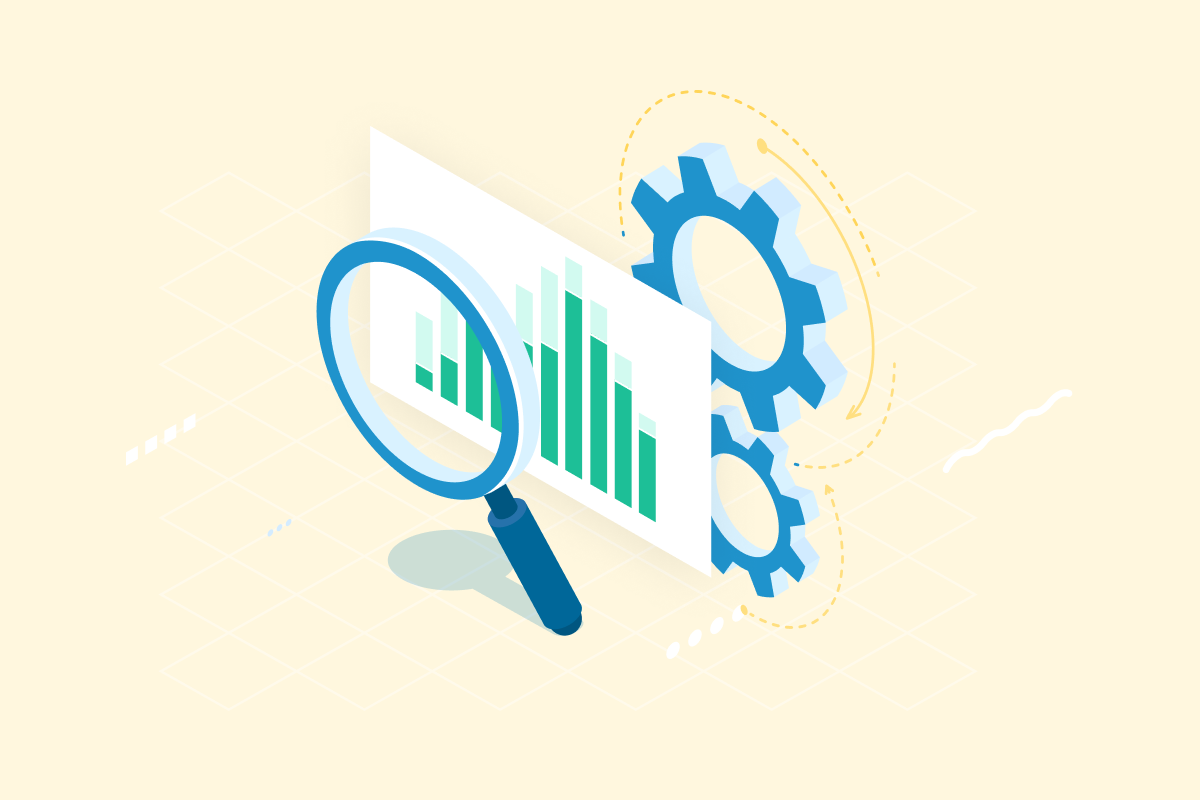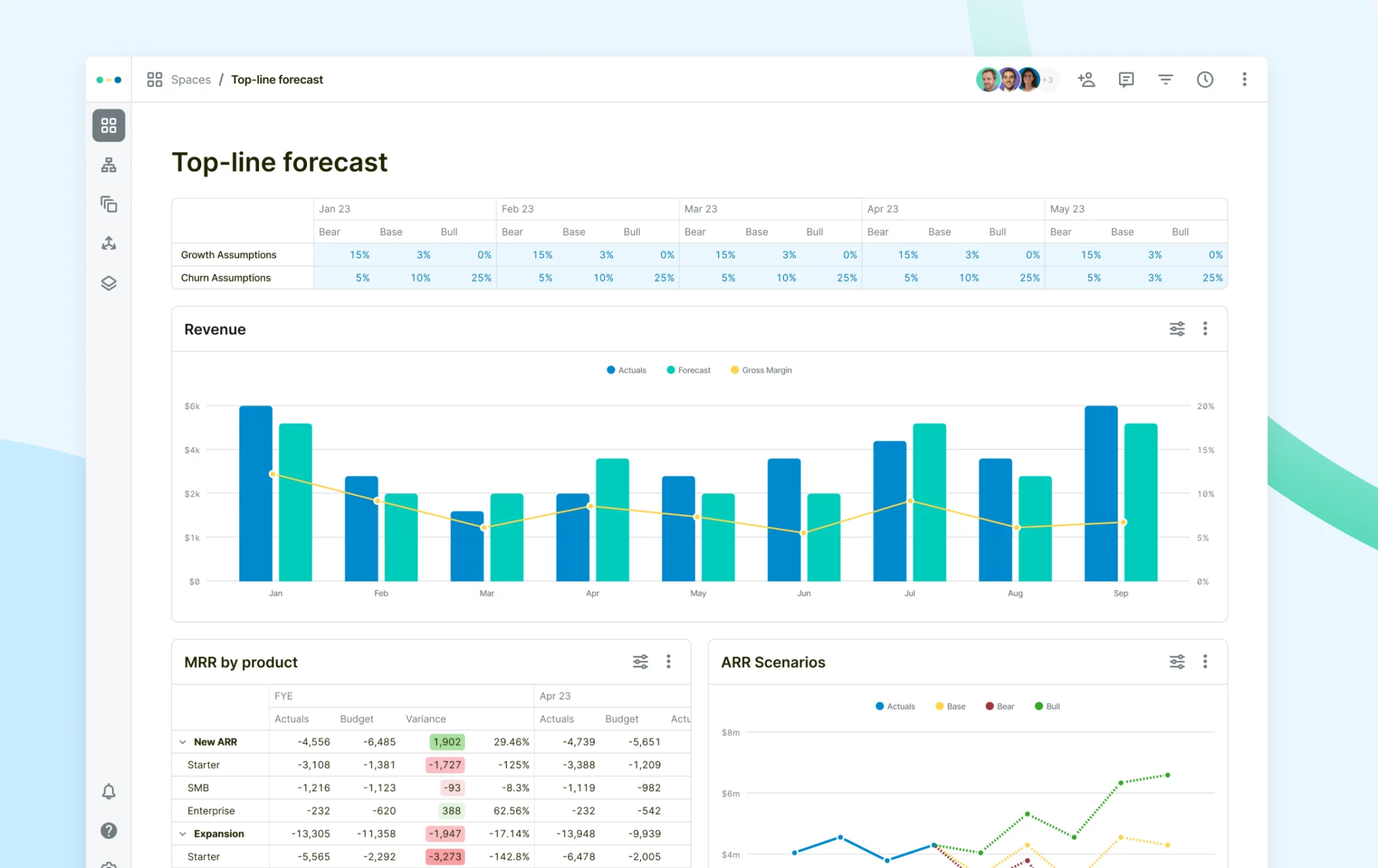
The value behind RevOps and how to get started
Learn more ->

, Chief of Staff, Abacum
13 min read · Published: August 9, 2023

🎯 Introduction
In today’s competitive business landscape, revenue forecasting plays a crucial role in the success and growth of any organization. By accurately predicting future revenue streams, businesses can make informed decisions, allocate resources effectively, and drive sustainable profitability.
In this article you will explore the importance of revenue forecasting, different forecasting models, a step-by-step guide to building your own model, and answers to common questions surrounding this essential business practice.
Revenue forecasting plays a vital role in business planning, providing insights into future financial performance and helping organizations set realistic goals. By analyzing historical data, market trends, and other relevant factors, businesses can anticipate their revenue streams, identify potential risks, and optimize their sales strategies. Revenue forecasting serves as the foundation for financial planning, budgeting, and resource allocation, enabling companies to align their operations with their revenue targets.
One of the key reasons why revenue forecasting is crucial for businesses is that it allows them to assess their financial health and plan accordingly. By accurately predicting future revenue streams, organizations can make informed decisions about resource allocation, ensuring that they have the necessary funds to support their operations and growth initiatives. This helps businesses avoid cash flow problems and ensures that they are financially prepared for any challenges that may arise.
In addition to financial planning, revenue forecasting also plays a significant role in strategic decision-making. By understanding their expected revenue, businesses can assess the feasibility of new ventures and determine the potential return on investment. This information is invaluable when it comes to evaluating the viability of expanding into new markets, launching new products or services, or making any other strategic business decisions.
Revenue forecasting is an integral part of the business planning process. It helps organizations set achievable revenue targets and develop strategic initiatives to achieve those goals. By utilizing revenue forecasts, businesses can assess the feasibility of new ventures, make informed decisions about resource allocation, and create comprehensive financial projections for investors and stakeholders.
When it comes to setting revenue targets, organizations need to strike a balance between ambition and realism. Revenue forecasts help businesses determine what is achievable based on historical data, market trends, and other relevant factors. This ensures that the targets set are challenging yet attainable, motivating employees and driving the company towards success.
Moreover, revenue forecasting is not just limited to setting targets. It also helps businesses identify potential risks and opportunities. By analyzing historical data and market trends, organizations can identify patterns and make predictions about future revenue streams. This allows them to proactively address any potential challenges and capitalize on emerging opportunities, giving them a competitive edge in the market.
An accurate revenue forecast provides numerous benefits for businesses of all sizes. By accurately predicting future revenue streams, organizations can optimize their inventory levels, streamline production processes, and adjust their pricing strategies. This ensures that businesses have the right amount of inventory to meet customer demand, minimizing excess inventory costs and avoiding stockouts.
Accurate revenue forecasting also enables businesses to make data-driven decisions about their pricing strategies. By understanding their expected revenue, organizations can assess the impact of different pricing scenarios and determine the optimal pricing strategy to maximize profitability. This helps businesses stay competitive in the market and attract customers while maintaining a healthy profit margin.
Additionally, accurate revenue forecasting allows businesses to identify potential cash flow challenges and take proactive measures to mitigate them. By understanding their expected revenue, organizations can anticipate periods of low cash flow and take steps to manage their expenses or secure additional funding. This helps businesses avoid cash flow problems and ensures that they can continue to operate smoothly even during challenging times.
Furthermore, accurate revenue forecasting enables companies to assess the impact of external factors, such as market conditions or regulatory changes, and make timely adjustments to their sales and marketing strategies. By monitoring market trends and analyzing their revenue forecasts, organizations can identify shifts in customer behavior or market dynamics and adapt their strategies accordingly. This flexibility allows businesses to stay agile and responsive in a rapidly changing business environment.
Various revenue forecasting models can help businesses predict sales and revenue streams more effectively. Each model offers unique insights and can be tailored to suit different industries and business needs.
Let’s explore some popular revenue forecasting models:
The Quota Capacity Model focuses on the capacity of the sales team to achieve their sales targets. By analyzing historical sales data, individual sales quotas, and overall capacity, organizations can forecast future revenue based on their sales team’s performance. This model helps businesses understand their sales team’s capabilities, prioritize opportunities, and identify areas for improvement.
For example, a software company may use the Quota Capacity Model to assess the performance of its sales team. By analyzing past sales data, they can determine if their sales representatives are consistently meeting their quotas or if there are any patterns of underperformance. This information can help the company identify training needs, adjust sales targets, and allocate resources more effectively.
In addition, the Quota Capacity Model can also help businesses identify potential bottlenecks in their sales process. By analyzing the capacity of the sales team and comparing it to the demand for their product or service, organizations can identify if they have enough resources to meet customer demand. This can inform hiring decisions, expansion plans, and overall business strategy.
The ARR Snowball Model is commonly used by subscription-based businesses to forecast their recurring revenue growth. It considers factors such as customer churn rate, average revenue per customer, and new customer acquisition. By tracking these metrics, businesses can project their future revenue growth and identify strategies to optimize customer retention and acquisition.
For instance, a subscription-based streaming service may use the ARR Snowball Model to forecast its revenue growth. By analyzing the churn rate (the rate at which customers cancel their subscriptions), the average revenue per customer, and the rate of acquiring new customers, the company can estimate its future revenue streams. This information can help the company develop strategies to reduce customer churn, increase average revenue per customer, and attract new customers through targeted marketing campaigns or product enhancements.
Moreover, the ARR Snowball Model can also assist businesses in identifying potential market opportunities. By analyzing customer acquisition rates and revenue growth in different market segments, organizations can identify which segments are performing well and where there is room for growth. This can guide businesses in allocating resources, targeting specific customer groups, and expanding into new markets.
The Sales Cycle to New Bookings Model focuses on the sales pipeline and conversion rates at each stage of the sales cycle. By analyzing past performance and conversion rates, organizations can predict future revenue based on their sales pipeline. This model helps sales teams identify potential bottlenecks, optimize their sales processes, and improve forecasting accuracy.
For example, a manufacturing company may use the Sales Cycle to New Bookings Model to forecast its sales pipeline. By analyzing the time it takes for leads to convert into customers at each stage of the sales cycle, the company can estimate the number of new bookings they can expect in the future. This information can help the company identify potential bottlenecks in the sales process, such as long lead times or low conversion rates, and take corrective actions to improve efficiency and increase revenue.
In addition, the Sales Cycle to New Bookings Model can also provide valuable insights into customer behavior and preferences. By analyzing conversion rates and customer feedback at each stage of the sales cycle, organizations can identify patterns and trends that can inform marketing strategies, product development, and customer relationship management. This can lead to more targeted and effective sales efforts, resulting in increased revenue and customer satisfaction.
The Bookings, Billings, and Collections Model provides a comprehensive view of revenue flow throughout the sales cycle. It considers factors such as bookings (orders placed), billings (invoices issued), and collections (cash collected). By tracking these metrics, businesses can anticipate their cash flow and identify potential gaps or delays in revenue collection.
For instance, a consulting firm may use the Bookings, Billings, and Collections Model to track its revenue flow. By analyzing the number of bookings (client engagements), the amount invoiced (billings), and the cash collected (collections), the firm can monitor its cash flow and identify any discrepancies or delays in payment. This information can help the firm manage its financial resources more effectively, negotiate payment terms with clients, and plan for future expenses.
Moreover, the Bookings, Billings, and Collections Model can also help businesses identify areas for process improvement. By analyzing the time it takes for bookings to turn into billings and collections, organizations can identify potential bottlenecks in their invoicing and payment processes. This can lead to streamlined operations, reduced payment delays, and improved cash flow management.
Building a revenue forecasting model requires careful analysis of historical data, market trends, and relevant business factors.
By following these steps, you can create an accurate revenue forecast for your organization:
To begin, assess your historical customer growth rate and average Annual Recurring Revenue (ARR). Utilize market research, industry benchmarks, and internal data to make informed assumptions about future customer growth and ARR. These assumptions will form the basis of your revenue forecast.
When analyzing historical customer growth, consider factors such as marketing efforts, customer acquisition strategies, and market conditions. Look for patterns and trends that can help you identify potential growth opportunities or challenges.
Additionally, when determining the average ARR, take into account pricing strategies, product enhancements, and customer feedback. Analyze how these factors have influenced the average revenue generated per customer over time.
By thoroughly understanding your customer growth and average ARR, you can make more accurate assumptions for your revenue forecast, which will ultimately help you make informed business decisions.
Next, calculate your Net New Bookings by considering new customer acquisition and upselling opportunities. Incorporate factors such as conversion rates, pricing changes, and market trends to estimate your future bookings accurately. This step will help you project your revenue streams in a realistic and achievable manner.
When analyzing new customer acquisition, evaluate your marketing and sales strategies. Identify the channels that have been most successful in attracting new customers and assess the effectiveness of your lead generation efforts. Consider the conversion rates at each stage of the sales funnel to estimate the number of new customers you can expect in the future.
Furthermore, when evaluating upselling opportunities, analyze customer behavior and purchasing patterns. Look for cross-selling or upselling opportunities within your existing customer base and determine the potential revenue impact of these strategies.
By incorporating these factors into your revenue projection, you can gain a more comprehensive understanding of your future revenue streams and make strategic decisions to drive growth.
Renewal bookings are crucial for maintaining revenue continuity in subscription-based businesses. Assess your historical renewal rates, customer satisfaction levels, and contract terms to model your future renewal bookings. By factoring in potential churn and renewal rates, you can accurately forecast your revenue streams and understand the impact of customer retention on your organization.
When analyzing historical renewal rates, consider the reasons why customers choose to renew or not renew their subscriptions. Look for patterns or commonalities among customers who have renewed and those who have churned. This analysis can help you identify areas for improvement and develop strategies to increase customer retention.
Additionally, evaluate customer satisfaction levels through surveys, feedback, and support interactions. Identify areas where you can enhance the customer experience and address any pain points that may contribute to customer churn.
By modeling your renewal bookings based on these factors, you can gain insights into the future revenue continuity of your business and implement strategies to improve customer retention.
Lastly, calculate your billings and collections to analyze your cash flow. Consider factors such as payment terms, invoicing accuracy, and collection efficiency to forecast your cash flow accurately. By understanding your cash flow dynamics, you can proactively address potential challenges and optimize your financial operations.
When analyzing payment terms, assess the average time it takes for customers to pay their invoices. Consider any seasonal or industry-specific factors that may affect payment timelines. This analysis will help you estimate the timing of your cash inflows and outflows.
In terms of invoicing accuracy, evaluate your billing processes to ensure that invoices are generated correctly and promptly. Identify any bottlenecks or inefficiencies that may delay the invoicing process and impact your cash flow.
Furthermore, when assessing collection efficiency, analyze your collection practices and policies. Identify any overdue accounts or potential risks of non-payment. Develop strategies to improve collection rates and minimize the impact of late payments on your cash flow.
By accurately calculating your billings and collections, you can gain a deeper understanding of your cash flow dynamics and make informed decisions to optimize your financial operations.
Learn more:
Revenue forecasting is a crucial aspect of understanding a business’s financial performance. It allows organizations to anticipate future revenue streams, identify potential challenges, and make informed decisions. However, to truly maximize the benefits of revenue forecasting, businesses can take their top-line planning to the next level by integrating it with other planning processes.
Furthermore, integrating revenue forecasting with financial goals is essential for effective top-line planning. By aligning revenue projections with financial targets, businesses can better manage cash flows, plan investments, and make strategic financial decisions. This integration ensures that financial resources are allocated efficiently and effectively, maximizing the chances of achieving desired financial outcomes.
While integration is crucial, leveraging advanced analytics, predictive technologies, and real-time data can further enhance the accuracy and agility of revenue forecasting. Advanced analytics tools can analyze historical data, market trends, and customer behavior to generate more accurate revenue forecasts. Predictive technologies can help businesses anticipate future revenue streams based on various scenarios and assumptions. Real-time data integration allows organizations to monitor revenue performance continuously, identify deviations from forecasts, and make timely adjustments.
In conclusion, while revenue forecasting provides valuable insights into a business’s financial performance. It acts as a guide, enabling the prediction of future revenue streams, anticipating potential challenges, and supporting well-informed decision-making.
However, the true power of revenue forecasting emerges when it seamlessly integrates with other essential planning aspects. This is precisely where a solution like Abacum comes into play.

Abacum FP&A software empowers to discern what’s effective, what’s not, and how to take actionable steps to achieve desired outcomes. Connect with an Abacum FP&A consultant today to kickstart the conversation.
Excel is a widely used tool for revenue forecasting but when it comes to revenue forecasting, accuracy is key. Excel offers various data analysis tools that can help businesses make more informed projections. These tools include regression analysis, moving averages, and exponential smoothing. By leveraging these tools, businesses can analyze historical data, identify trends, and make predictions based on patterns.
Formula optimization is another important aspect of forecasting in Excel. By using the right formulas and functions, businesses can automate calculations and save time. Excel provides a wide range of formulas that can be used for revenue forecasting, such as SUM, AVERAGE, and IF, that can be used to perform complex calculations. Additionally, businesses can create custom formulas to suit their specific forecasting needs.